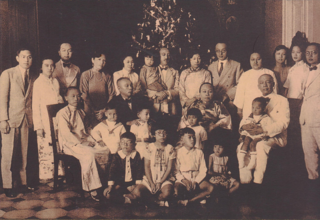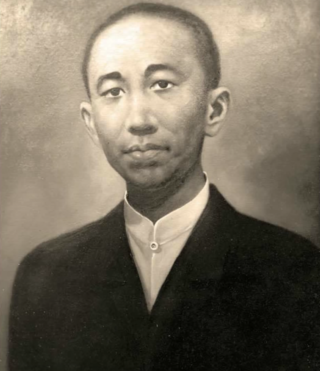Related Research Articles

Raden Saleh Sjarif Boestaman was a pioneering Indonesian Romantic painter of Arab-Javanese ethnicity. He was considered to be the first "modern" artist from Indonesia, and his paintings corresponded with nineteenth-century romanticism which was popular in Europe at the time. He also expressed his cultural roots and inventiveness in his work.

The Cultivation System was a Dutch government policy from 1830–1870 for its Dutch East Indies colony. Requiring a portion of agricultural production to be devoted to export crops, it is referred to by Indonesian historians as tanam paksa.

The Vorstenlanden were four native, princely states on the island of Java in the colonial Dutch East Indies. They were nominally self-governing vassals under suzerainty of the Kingdom of the Netherlands. Their political autonomy however became increasingly constrained by severe treaties and settlements. Two of these continue to exist as a princely territory within the current independent republic of Indonesia.
Karawaci is a district of Tangerang City, Banten, Indonesia. It has an area of 13.475 km² and a population of 184,388 at the 2020 Census. Lippo Karawaci, a planned community, is located here.

Bekasi Regency is a regency of West Java Province, Indonesia. Its regency seat is in the district of Central Cikarang. It is bordered by Jakarta Special Region and by Bekasi City to the west, by Bogor Regency to the south, by Karawang Regency to the east and by the Java Sea to the north.

Benteng people are a Chinese Indonesian community of 'Peranakan' or mixed descent, native to the historic Tangerang area in the modern-day Indonesian provinces of Jakarta, Banten and West Java.
Khouw Tian Sek, Luitenant der Chinezen, popularly known as Teng Seck, was a Chinese Indonesian landlord in colonial Batavia. He is best known today as the patriarch of the prominent Khouw family of Tamboen.
Tan Liok Tiauw Sia was a prominent Chinese-Indonesian landowner, planter and industrial pioneer in the late colonial period, best known today as the last Landheer of Batoe-Tjepper, now the district of Batuceper.
Lauw Tek Lok, Luitenant der Chinezen was a high-ranking government official and landlord in Batavia, Dutch East Indies, and a member of the Lauw-Sim-Zecha family, part of Java’s Cabang Atas gentry. He is remembered today for his long tenure as Luitenant der Chinezen of Bekasi, and for his interracial marriage with Louisa Zecha.

The Lauw-Sim-Zecha family is an Indonesian family of the 'Cabang Atas' or the Chinese gentry of the Dutch East Indies. They came to prominence at the start of the nineteenth century as Pachters, Landheeren (landlords) and Kapitan Cina in the colonial capital, Batavia, and in the hill station of Sukabumi, West Java. The family is of mixed Peranakan Chinese and Indo-Bohemian descent.

The Cabang Atas —literally 'highest branch' in Indonesian—was the traditional Chinese establishment or gentry of colonial Indonesia. They were the families and descendants of the Chinese officers, high-ranking colonial civil bureaucrats with the ranks of Majoor, Kapitein and Luitenant der Chinezen. They were referred to as the baba bangsawan [‘Chinese gentry’] in Indonesian, and the ba-poco in Java Hokkien.
Oei Tjie Sien was a Chinese-born colonial Indonesian tycoon and the founder of Kian Gwan, Southeast Asia's largest conglomerate at the start of the twentieth century. He is better known as the father of Oei Tiong Ham, Majoor-titulair der Chinezen (1866–1924), who modernized and vastly expanded the Oei family's business empire.

Han Oen Lee, Luitenant der Chinezen (1856—1893) was a magnate of Chinese descent in the Dutch East Indies, who governed the Chinese community of Bekasi as its Luitenant der Chinezen, an important administrative post in the Dutch colonial bureaucracy. He was also the Landheer (landlord) of the particuliere land of Gaboes. Today, he is best known as the father of the late colonial statesman Hok Hoei Kan (1881—1951).
Kang Keng Tjong, also spelt Kan Keng Tiong, was a Chinese-Indonesian tycoon and one of the richest men in Batavia, capital of the Dutch East Indies.
The institution of the pacht or pacht-stelsel was a system of tax farming in the Dutch Republic and its colonial empire. In this system tax is not collected by the government, but by a private individual who has leased the right to collect the tax. In the Dutch Republic, for example, this was common practise for a long time, especially for indirect taxes. Each year, the highest bidder acquired the right to collect certain taxes; he paid a rent for this to the government, and all he collected more was for the tax tenant himself. The rationale behind this system was that by outsourcing taxation, local governments could exert less influence on collection. Also, a tenant would collect taxes more scrupulously, because it would personally benefit him.
In the Dutch East Indies, a Landheer was the lord or owner of a particuliere landerij, a private domain in a feudal system of land tenure used in parts of the colony. Dutch jurists described the legal jurisdiction of a Landheer over his domain as ‘sovereign’ and comparable to that of the rulers of indirectly ruled princely states in the Indies. By law, the Landheer possessed landsheerlijke rechten or hak-hak ketuanan [seigniorial jurisdiction] over the inhabitants of his domain — jurisdiction exercised elsewhere by the central government.

Oey Djie San, Kapitein der Chinezen was a Chinese-Indonesian public figure, bureaucrat and landlord, best known for his role as Landheer of Karawatji and Kapitein der Chinezen of Tangerang. In the latter capacity, he headed the local Chinese civil administration in Tangerang as part of the Dutch colonial system of 'indirect rule'.

Oey Giok Koen, Kapitein der Chinezen was a Chinese-Indonesian public figure, bureaucrat and Landheer, best known for his role as Kapitein der Chinezen of Tangerang and Meester Cornelis, and as one of the richest landowners in the Dutch East Indies. As Kapitein, he headed the local Chinese civil administration in Tangerang and Meester Cornelis as part of the Dutch colonial system of 'indirect rule'. In 1893, he bought the particuliere landen or private domains of Tigaraksa and Pondok Kosambi.
Oey Khe Tay, Kapitein der Chinezen was a Chinese-Indonesian bureaucrat and landlord, best known for his role as Kapitein der Chinezen of Tangerang and Landheer of Karawatji. In the former capacity, he acted as the head of the Chinese civil administration in Tangerang as part of the Dutch colonial system of ‘indirect rule’.
Tan Tiang Po, Luitenant der Chinezen, also spelled Tan Tjeng Po, was a colonial Chinese-Indonesian bureaucrat, landowner, philanthropist and the penultimate Landheer (landlord) of the domain of Batoe-Tjepper in the Dutch East Indies.
References
- 1 2 3 4 5 Kropveld, D. C. J. H. (1911). The Laws of Netherland East India Relating to Land: Being a Short Exposition of Their Leading Principles and Chief Provisions, and an Explanation of Dutch Terms, with Chapters on Netherland East India and Its Laws in General and on Dutch East Indian Mining Law. Stevens. Retrieved 15 July 2020.
- 1 2 3 4 5 Anderson, Benedict Richard O'Gorman (2006). Java in a Time of Revolution: Occupation and Resistance, 1944-1946. Equinox Publishing. ISBN 978-979-3780-14-6 . Retrieved 15 July 2020.
- 1 2 3 4 5 6 7 8 9 10 Cribb, Robert (2008). Gangsters and Revolutionaries: The Jakarta People's Militia and the Indonesian Revolution, 1945-1949. Singapore: Equinox Publishing. ISBN 978-979-3780-71-9 . Retrieved 15 July 2020.
- 1 2 Creutzberg, P. (2012). Indonesia's Export Crops 1816–1940. Springer Science & Business Media. ISBN 978-94-011-6437-5 . Retrieved 15 July 2020.
- 1 2 3 4 5 6 7 8 9 10 11 12 13 Nola, Luthvi Febryka (November 2013). [jurnal.dpr.go.id "Sengketa Tanah Partikelir"]. Jurnal DPR RI. 4 (2): 183–196. Retrieved 15 July 2020.
{{cite journal}}: Check|url=value (help) - 1 2 3 4 5 6 Kahin, Audrey (2015). Historical Dictionary of Indonesia. Rowman & Littlefield. ISBN 978-0-8108-7456-5 . Retrieved 15 July 2020.
- 1 2 3 4 5 Gautama, Sudargo; Harsono, Budi (1972). Agrarian Law. Lembaga Penelitian Hukum dan Kriminologi, Universitas Padjadjaran. Retrieved 15 July 2020.
- 1 2 3 4 5 Indonesia Circle. Indonesia Circle, School of Oriental and African Studies. 1996. Retrieved 15 July 2020.
- ↑ "Particuliere landerijen - de betekenis volgens Agrarisch".
- ↑ Goh, Taro (1998). Communal Land Tenure in Nineteenth-century Java: The Formation of Western Images of the Eastern Village Community. Department of Anthropology, Research School of Pacific and Asian Studies, Australian National University. ISBN 978-0-7315-3200-1 . Retrieved 17 July 2020.
- ↑ Dick, Howard; Sullivan, Michael; Butcher, John (1993). The Rise and Fall of Revenue Farming: Business Elites and the Emergence of the Modern State in Southeast Asia. Springer. ISBN 978-1-349-22877-5 . Retrieved 15 July 2020.
- ↑ Rush, James R. (2007). Opium to Java: Revenue Farming and Chinese Enterprise in Colonial Indonesia, 1860-1910. Equinox Publishing. ISBN 978-979-3780-49-8 . Retrieved 15 July 2020.
- ↑ Milone, Pauline Dublin (1967). "Indische Culture, and Its Relationship to Urban Life". Comparative Studies in Society and History. 9 (4): 407–426. doi:10.1017/S0010417500004618. ISSN 0010-4175. JSTOR 177686. S2CID 143944726.
- ↑ Heuken, Adolf (2007). Historical Sites of Jakarta. Cipta Loka Caraka. Retrieved 15 July 2020.
- ↑ Salmon, Claudine (2006). "Women's Social Status as Reflected in Chinese Epigraphs from Insulinde (16th-20th Centuries)". Archipel. 72 (1): 157–194. doi:10.3406/arch.2006.4030.
- 1 2 3 4 5 6 7 Peratoeran baroe atas tanah-tanah particulier di tanah Djawa seblah Roelan Tjimanoek (Staatsblad 1912 No. 422). Batavia: Landsdrukkerij. 1913. p. 24.